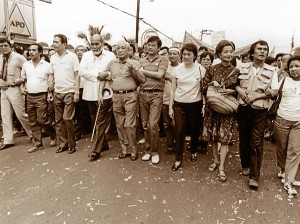Even for the residents of Batanes—where squat stone houses attest to the province’s reputation as the storm capital of the country—Typhoon “Ferdie” was the strongest in recent memory.
Ferdie made landfall in Batanes early on Sept. 14. It left no casualty, thanks to the typhoon-ready mindset and disaster preparedness of the province and its people, but it affected some 10,000 individuals and inflicted damage to crops and infrastructure to the tune of a reported P450 million.
The Office of Civil Defense in the Cagayan region estimated that P37 million worth of vegetables, root crops and corn were destroyed by the typhoon, and 292 houses were totally damaged and 932 partially damaged in the towns of Basco, Ivana and Uyugan. Government structures were likewise pounded—it was said that the winds were so strong it seemed like an earthquake was occurring—including 28 school buildings.
With power lines toppled along with trees, telecommunications were down and power was out in the towns of Basco, Mahatao and Itbayat—and are not expected to be restored in less than a month. That means the more than 2,000 families temporarily sheltered in their relatives’ homes and hundreds of others in three evacuation centers in Basco who lost their homes had little food, water, and communications, and no electricity for much of last week and well into the weekend.
But unlike in the case of “Yolanda,” which memorably altered not only lives but also the landscape in Central Philippines in November 2013, there was hardly news about battered Batanes. Sure, telecommunications were cut off and the province was too distant for news to reach Manila quickly, but it apparently took days for both officialdom and the private sector to take notice of Batanes’ distress.
In a text message sent to the Catholic Bishops’ Conference of the Philippines, Batanes Bishop Camilo Gregorio lamented how national government response had been slow: “We are safe but suffering. Financial aid needed. Please pray for us, we are still surviving. No government assistance at all.”
Can it be that everyone had been so transfixed by the storm unfolding before our eyes to be aware of anything else? The inquiry hearings in the Senate and the House, as well as the escalating drug-related body count—including as many as 13 drug suspects killed in a 24-hour span—continue to capture much of the public attention.
As it was, with little news trickling in about the sorry conditions in Batanes, relief goods and basic necessities have been slow to come. The calls for help were simply not getting through, and, of course, with weather conditions still poor, airlifts were not immediately possible. Batanes Gov. Malou Cayco was reported bringing in sacks of rice and a generator in a cargo plane. On Monday, Vice President and housing chief Leni Robredo flew in to inspect the damage in hardest-hit Itbayat and to reassure residents of assistance in rebuilding “tougher” homes. Upon returning, she relayed news about the extensive destruction and appealed for help for the Batanes folk.
As of the latest report, the second airlifted relief mission of the Department of Social Welfare and Development had mercifully reached Itbayat, delivering 20 sacks of rice, four boxes of bottled water, 20 boxes of canned goods and food packs, and assorted medical supplies. The DSWD under Social Welfare Secretary Judy Taguiwalo had prepared for airlift to Batanes such relief goods as 20,000 ready-to-eat brown rice packs, 5,000 malongs, 5,000 bottles of water, three generators, 40 rolls of rope, and 30 rolls of laminated sacks. We list these details to indicate the urgency of the need.
With Batanes placed under a state of calamity, government agencies and private groups and individuals are enjoined to contribute all they can to help its people pick up the pieces of their lives and start again. As it was in the past when help was needed, it’s again time to pull together and organize relief drives and fund-raising campaigns.
This is one call that can unite us, if briefly, in the face of the distressing, polarizing issues—the drug-related killings, the planned burial of the dictator’s remains in the Libingan ng mga Bayani—that threaten to swamp us in a flood of despair.


